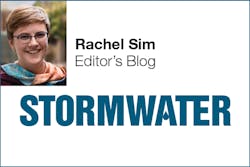There are so many good reasons to manage, treat, slow down, and capture stormwater runoff. It reduces nutrient pollution in our rivers, streams, and lakes. It prevents flooding, from combined sewers or otherwise, during storm events. It recharges groundwater supplies, which in turn provide nearly 40% of public water. But when budgets are tight, as they so often seem to be, it can be hard to find the money to implement and maintain stormwater best management practices (BMPs). Cost-sharing programs are one option municipalities can use to not only lessen the financial burden, but to get residents engaged and invested in managing stormwater runoff.
Located just 35 miles south-east of Seattle, the city of Puyallup, WA, has one such cost-sharing initiative in place, now in its tenth year. Begun in 2009, the Puyallup Rain Garden Program encourages residential property owners to install green stormwater infrastructure such as permeable pavers, rain barrels, and rain gardens on their properties by offering up to $8,625 in reimbursements. The city’s Senior Engineer, Paul Marrinan, told the Tacoma News Tribune that the program has helped the city divert over 20 million gallons of stormwater from Puget Sound.
Funding stormwater projects is often challenging and the pay-off for good stormwater management isn’t immediately visible. A program like this can educate residents and prompt them to engage and invest (financially or otherwise) in their community’s stormwater goals. In fact, the Puyallup Rain Garden Program website encourages visitors to tour some of the rain program demo sites by linking to a Google map with the locations and descriptions of many the city’s rain gardens.
Another challenge for municipalities is that many stormwater BMPs aren’t “set it and forget it”—to be effective long-term, they must be maintained. Cost-sharing programs like the one in Puyallup can offer a way for municipalities to share the load of managing runoff and reducing impervious surfaces. For example, in addition to their share of the costs associated with creating the rain gardens, residents in Puyallup are also responsible for any future maintenance costs.
Does your municipality have a cost-sharing program for stormwater infrastructure? We want to hear from you—send your experiences, thoughts, and comments to [email protected].






